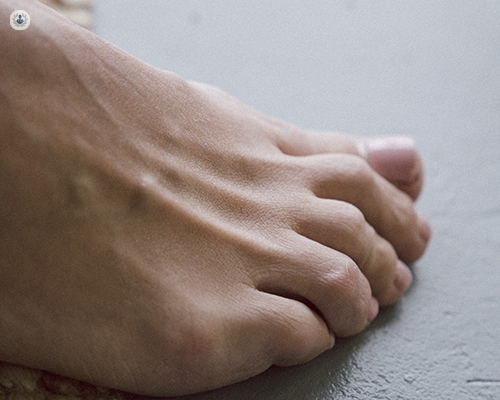What are the common symptoms and signs of big toe arthritis?
Written in association with:In one of our latest medical articles below, Mr Shelain Patel, a highly respected consultant foot and ankle surgeon, provides an all-you-need-to-know guide with regards to big toe arthritis.

What are the common symptoms and signs of big toe arthritis?
Common presentations are pain and swelling in the big toe joint which is otherwise known as the MTP joint. Pain can limit activities, whilst swelling may interfere with wearing close fitting shoes. Arthritis can also lead to stiffness, and this means initial ‘push-off’ when walking becomes more difficult and changes the way a patient walks.
One sign of big toe arthritis is a continuous hard swelling which is tender to touch. This particularly noticeable on the top of the big toe joint and relates to bone spurs.
What are the causes and risk factors associated with developing arthritis in the big toe?
In most cases, there is probably some history of trauma. It may not even be something that a patient recalls, but either stubbing the toe badly or being trodden on has disturbed the lining of the joint and led to wear and tear. It may take many years though for it to become evident. Other causes could be inflammatory diseases such as rheumatoid arthritis, or crystal arthropathies such as gout.
How is big toe arthritis diagnosed, and what are the available treatment options?
The diagnosis is made after a triple assessment of history, examination, and imaging. Most of the time, a good history and examination will identify the problem and imaging such as X-rays or MRI helps define what treatment is needed.
Options are variable and range from conservative solutions such as changes in footwear and lifestyle activities, to invasive techniques that include injections. Once these fail, or if the arthritis is too severe, it may be that an operation is all that can be offered.
Is surgery necessary for big toe arthritis, and what are the surgical procedures involved?
Surgery is only necessary if symptoms cannot be controlled in any other way. Surgical options vary widely but range from shaving extra bone away, to replacing parts of the joint, to fusing the joint.
What can patients do to manage big toe arthritis symptoms and maintain foot health in the long term?
Once arthritis sets in, it is important to be aware that careful management can minimise symptoms in most patients. Often being sensible with footwear, avoiding activities that exacerbate symptoms and taking simple painkillers will be all that is needed. However, specialist input is suggested when those measures fail.
If you wish to make an appointment with Mr Shelain Patel, you can do so via his Top Doctors profile.


